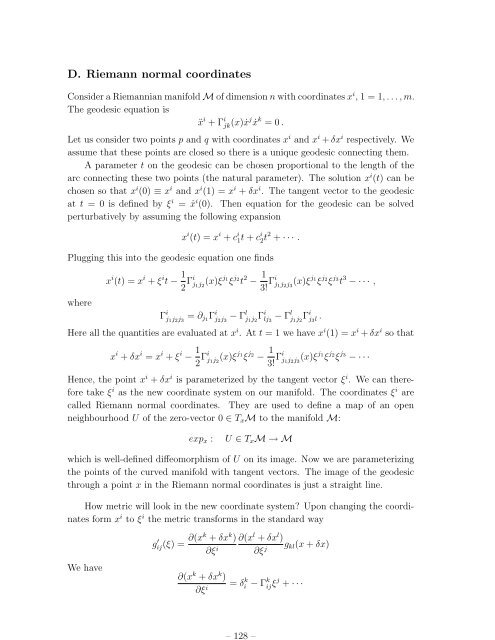Lectures on String Theory
Lectures on String Theory
Lectures on String Theory
You also want an ePaper? Increase the reach of your titles
YUMPU automatically turns print PDFs into web optimized ePapers that Google loves.
– 128 –<br />
D. Riemann normal coordinates<br />
C<strong>on</strong>sider a Riemannian manifold M of dimensi<strong>on</strong> n with coordinates x i , 1 = 1, . . . , m.<br />
The geodesic equati<strong>on</strong> is<br />
ẍ i + Γ i jk(x)ẋ j ẋ k = 0 .<br />
Let us c<strong>on</strong>sider two points p and q with coordinates x i and x i + δx i respectively. We<br />
assume that these points are closed so there is a unique geodesic c<strong>on</strong>necting them.<br />
A parameter t <strong>on</strong> the geodesic can be chosen proporti<strong>on</strong>al to the length of the<br />
arc c<strong>on</strong>necting these two points (the natural parameter). The soluti<strong>on</strong> x i (t) can be<br />
chosen so that x i (0) ≡ x i and x i (1) = x i + δx i . The tangent vector to the geodesic<br />
at t = 0 is defined by ξ i = ẋ i (0). Then equati<strong>on</strong> for the geodesic can be solved<br />
perturbatively by assuming the following expansi<strong>on</strong><br />
x i (t) = x i + c i 1t + c i 2t 2 + · · · .<br />
Plugging this into the geodesic equati<strong>on</strong> <strong>on</strong>e finds<br />
where<br />
x i (t) = x i + ξ i t − 1 2 Γi j 1 j 2<br />
(x)ξ j 1<br />
ξ j 2<br />
t 2 − 1 3! Γi j 1 j 2 j 3<br />
(x)ξ j 1<br />
ξ j 2<br />
ξ j 3<br />
t 3 − · · · ,<br />
Γ i j 1 j 2 j 3<br />
= ∂ j1 Γ i j 2 j 3<br />
− Γ l j 1 j 2<br />
Γ i lj 3<br />
− Γ l j 1 j 2<br />
Γ i j 3 l .<br />
Here all the quantities are evaluated at x i . At t = 1 we have x i (1) = x i + δx i so that<br />
x i + δx i = x i + ξ i − 1 2 Γi j 1 j 2<br />
(x)ξ j 1<br />
ξ j 2<br />
− 1 3! Γi j 1 j 2 j 3<br />
(x)ξ j 1<br />
ξ j 2<br />
ξ j 3<br />
− · · ·<br />
Hence, the point x i + δx i is parameterized by the tangent vector ξ i . We can therefore<br />
take ξ i as the new coordinate system <strong>on</strong> our manifold. The coordinates ξ i are<br />
called Riemann normal coordinates. They are used to define a map of an open<br />
neighbourhood U of the zero-vector 0 ∈ T x M to the manifold M:<br />
exp x :<br />
U ∈ T x M → M<br />
which is well-defined diffeomorphism of U <strong>on</strong> its image. Now we are parameterizing<br />
the points of the curved manifold with tangent vectors. The image of the geodesic<br />
through a point x in the Riemann normal coordinates is just a straight line.<br />
How metric will look in the new coordinate system? Up<strong>on</strong> changing the coordinates<br />
form x i to ξ i the metric transforms in the standard way<br />
We have<br />
g ij(ξ) ′ = ∂(xk + δx k ) ∂(x l + δx l )<br />
g<br />
∂ξ i ∂ξ j kl (x + δx)<br />
∂(x k + δx k )<br />
∂ξ i = δ k i − Γ k ijξ j + · · ·

















